The Getaway (1972 film)
7 /10 1 Votes
85% Rotten Tomatoes Screenplay Walter Hill Duration | 7.5/10 IMDb 2/4 Roger Ebert Genre Action, Crime, Thriller Initial DVD release November 19, 1997 Language English | |||||||||||||||||||||||||||||||||
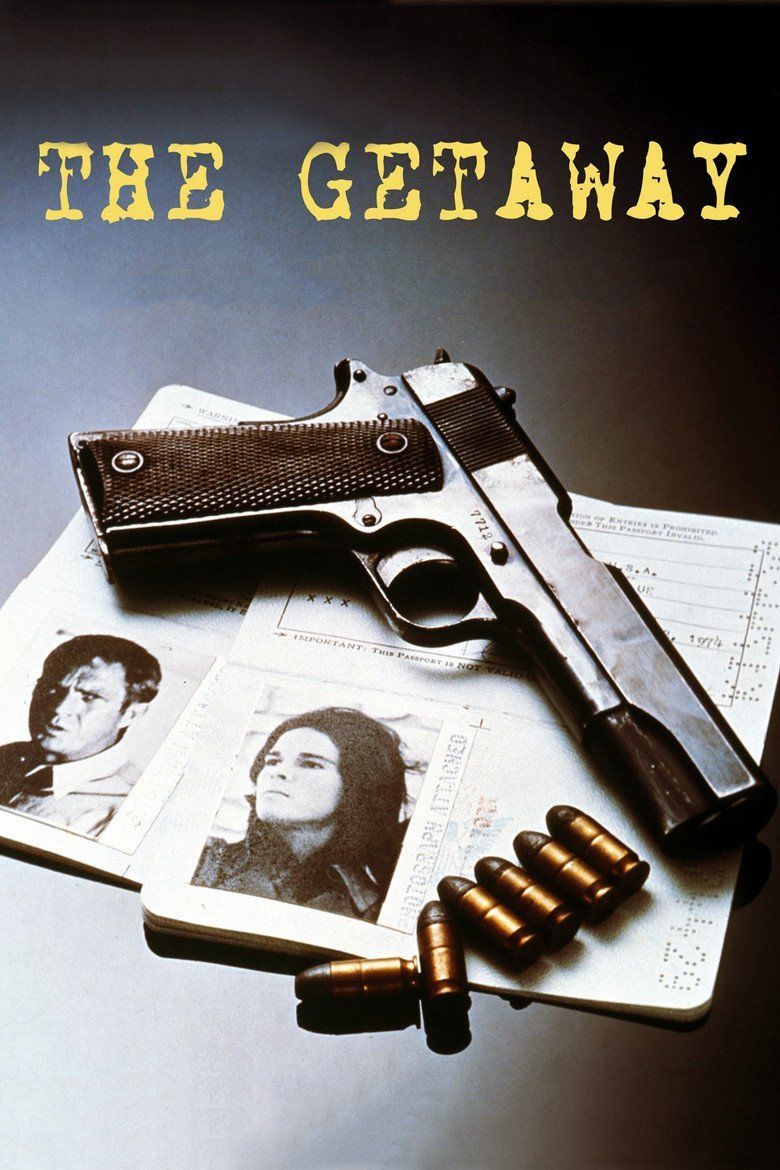 | ||||||||||||||||||||||||||||||||||
Release date December 13, 1972 (1972-12-13) Cast (Doc McCoy), (Carol McCoy), (Jack Beynon), (Rudy Butler), (Fran Clinton), (Cowboy) Similar movies The Asphalt Jungle , They Live by Night , The Prowler , Act of Violence , The Big Sleep , The Killing | ||||||||||||||||||||||||||||||||||
The Getaway is a 1972 American neo-noir crime film directed by Sam Peckinpah. The screenplay, written by Walter Hill, is based on the eponymous 1958 novel by Jim Thompson. Starring Steve McQueen, Ali MacGraw, Ben Johnson, Al Lettieri, Sally Struthers, Jack Dodson, Richard Bright and Slim Pickens, the film follows imprisoned mastermind robber Carter "Doc" McCoy (McQueen), whose wife Carol (MacGraw) conspires for his release on the condition they rob a bank in Texas. A double-cross follows the crime and the McCoys are forced to flee for Mexico with the police and criminals in hot pursuit. The film reunites McQueen and Peckinpah, having previously worked together in the commercially unsuccessful Junior Bonner, released the same year.
Contents
- Plot
- Development
- Writing
- Casting
- Filming
- Music
- Theatrical run and box office
- Home media
- Reception
- Remake
- References

Peter Bogdanovich, whose The Last Picture Show impressed McQueen and producer David Foster, was originally hired as the director of The Getaway. Thompson came on board to write the script of his crime novel's film adaptation. Creative differences ensued between Thompson and McQueen and the author was fired along with Bogdanovich—they were replaced with Hill and Peckinpah. Principal photography commenced on February 7, 1972, on location in Texas. During production, McQueen and MacGraw began an affair, and McQueen and Peckinpah were involved in heated arguments due to the latter's increasing alcohol intake. Originally scored by Peckinpah collaborator Jerry Fielding, McQueen became unimpressed with Fielding's soundtrack and, at his behest, hired Quincy Jones to rescore it. Jones was later nominated for a Golden Globe Award for Best Original Score for his work.
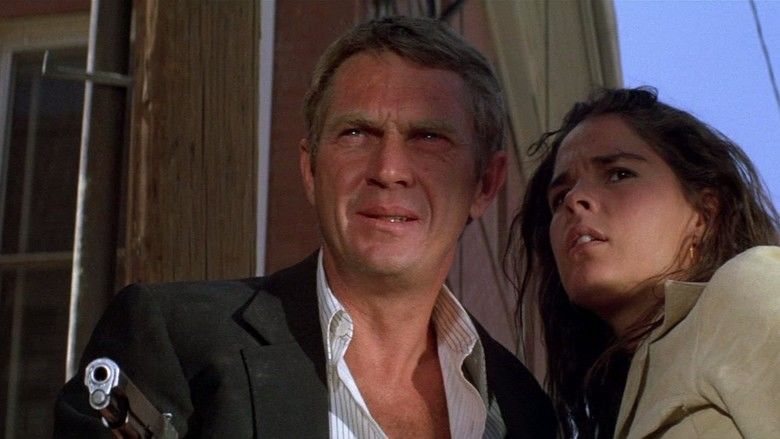
The Getaway was released on December 13, 1972. A box office hit earning over $36 million, it was the second highest-grossing film of the year, and was one of the most financially successful productions of Peckinpah's and McQueen's careers. On release the film attained a negative critical reception, with Vincent Canby of The New York Times and Roger Ebert of the Chicago Sun-Times both giving it indifferent reviews. Canby described the film as "aimless", while Ebert complained that the story was contrived, calling it "a big, glossy, impersonal mechanical toy". Nevertheless, the film was well received in retrospective reviews and was among the heist films considered the best. In 1994, a remake was released to generally negative reviews, directed by Roger Donaldson and starring Alec Baldwin and Kim Basinger.
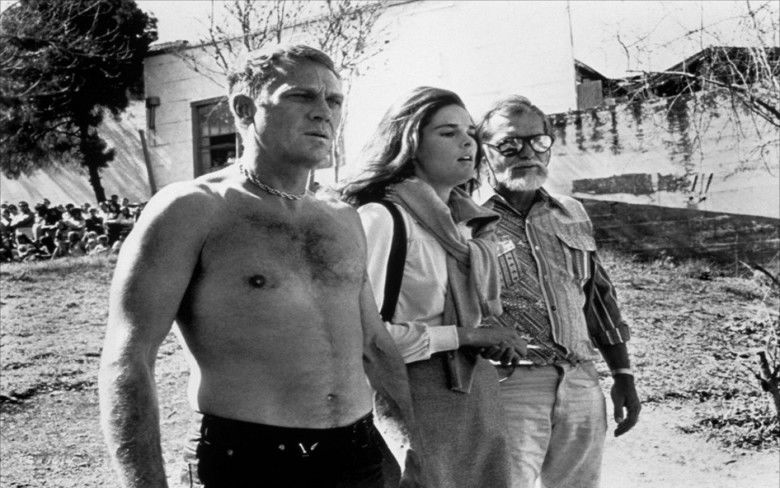
Plot

Serving four years of his ten-year sentence for armed robbery, Carter "Doc" McCoy is denied parole in a Texas prison. When his wife Carol visits him, he tells her to do whatever is necessary to make a deal with Jack Beynon, a corrupt businessman in San Antonio, to free him. Beynon uses his influence and obtains Doc's parole on the condition that he takes part in a bank robbery with two of his henchmen, Rudy and Frank. During the robbery, Frank kills a guard. Rudy attempts a double-cross, shooting Frank and drawing a gun on Doc, who beats him to the draw and shoots him several times. Doc leaves Rudy for dead, but Rudy, having secretly worn a bulletproof vest, is alive albeit wounded.
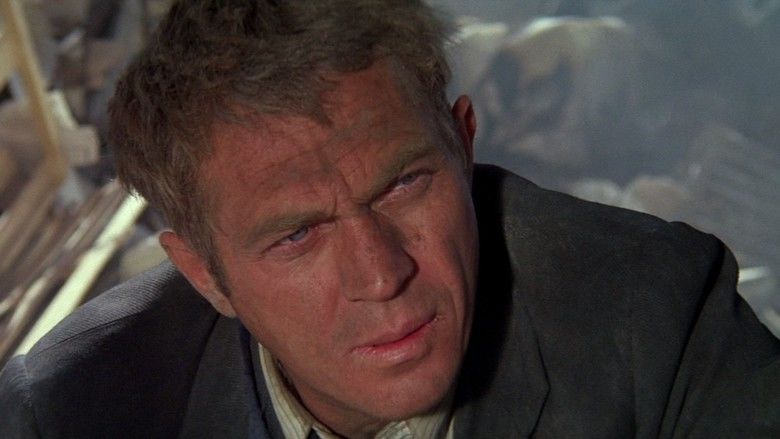
Doc meets with Beynon, who attempts a double-cross before Carol shoots and kills him. Doc realizes that Carol had sex with Beynon to secure his release from prison. He angrily gathers up the money and, after a bitter quarrel, the couple flees for the border at El Paso. A bloodied Rudy forces rural veterinarian Harold and his young wife Fran to treat his injuries, then kidnaps them to pursue Doc and Carol. Beynon's brother Cully and his thugs also pursue the McCoys. At a train station, a con man swaps locker keys with Carol and steals their bag of money. Doc follows him onto a train and forcefully takes it back. The injured con man and a train passenger–a boy whom Doc had rebuked for squirting him with a water gun–are taken to the police station, where they identify Doc's mug shot.

Carol buys a car, and the McCoys drive to an electronics store. As Doc buys a portable radio, he switches off the television set near the proprietor's desk broadcasting the news of the earlier incidents they were involved in. Suddenly, all the television sets in the store show Doc's picture, prompting him to leave immediately. The proprietor gets a glimpse of the picture, and calls the police. Doc steals a shotgun, followed by several shoot-outs and police chases. The couple escape by hiding in a large trash bin, only to end up in the back of a garbage truck that dumps its load at the local landfill. Filthy and frustrated, they argue about whether to stay together or split up. They decide to see things through.

Rudy's attraction to the veterinarian's wife leads to them having consensual sex in front of her husband. Humiliated, the vet hangs himself in a motel bathroom. Rudy and Fran move on, barely acknowledging the suicide. They check into an El Paso hotel used by criminals as a safe house because Rudy knows that the McCoys will be heading to the same place. When Doc and Carol check in at the hotel, they ask for food to be delivered, but the manager, Laughlin, says he is working alone and cannot leave the desk. Doc soon realizes that Laughlin sent his family away because something is about to happen. He urges Carol to dress quickly so they can escape. An armed Rudy comes to their door while Fran poses as a delivery girl who needs to be paid for the food. Peering from an adjacent doorway, Doc is surprised to see Rudy alive. He sneaks up behind Rudy, knocks him out, and does the same to Fran.
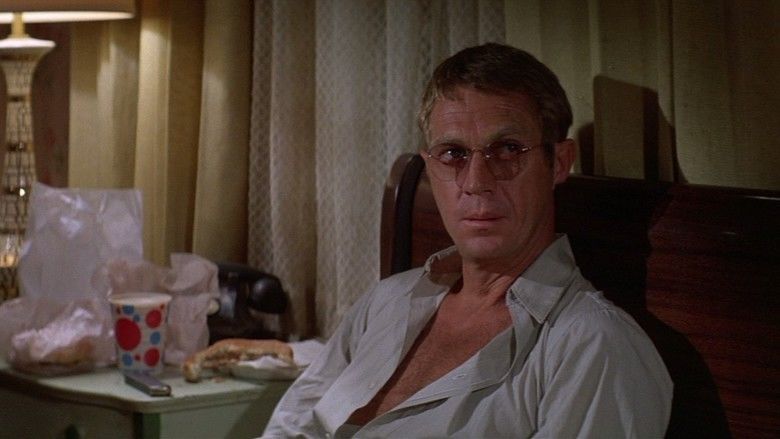
Cully and his thugs arrive as the McCoys try to leave. A violent gunfight ensues in the halls, stairwell, and elevator; all Cully's men are killed but one, who Doc allows to run away. Cully himself dies when Doc shoots the cables of the elevator he is in and it crashes to the bottom of the shaft. Rudy comes to his senses, follows Doc and Carol outside onto a fire escape, and shoots at them. Doc returns fire and kills him. With the police on the way, the couple hijack a pickup truck and force the driver, a cooperative old cowboy, to take them to Mexico. After crossing the border, Doc and Carol pay the cowboy $30,000 for his truck. Overjoyed, the cowboy heads back to El Paso on foot, while the couple continue into Mexico.
Development
Steve McQueen had been encouraging his publicist David Foster to enter the film industry for years, as a producer. His first attempt was Butch Cassidy and the Sundance Kid (1969), with McQueen starring alongside Paul Newman, but 20th Century Fox, particularly its president, Richard D. Zanuck, did not want Foster in the deal. Rather, Zanuck hired producer Paul Monash since he was the studio's profit maker, resulting in McQueen's departure from the project, which then fell apart. While McQueen was making Le Mans (1971) Foster acquired the rights to Jim Thompson's crime novel The Getaway. Foster sent McQueen a copy of the book urging him to do it. The actor was looking for a "good/bad guy" role and saw these qualities in the novel's protagonist, Doc McCoy.
Foster looked for a director and Peter Bogdanovich came to his attention. Bogdanovich's agent, Jeff Berg, set up a special screening of his client's soon-to-be released The Last Picture Show (1971) for Foster with McQueen in attendance. They loved it and met with the director and a deal was made. However, Warner Bros. approached Bogdanovich with an offer to direct What's Up, Doc? (1972), starring Barbra Streisand, with the stipulation that he had to start right away. The director wanted to do both, and the studio refused. When McQueen found out, he became upset and told Bogdanovich that he was going to get someone else to direct The Getaway.
McQueen had recently worked with director Sam Peckinpah on Junior Bonner (1972), and enjoyed the experience, but the film proved to be unsuccessful. He said: "Out of all my movies, Junior Bonner did not make one cent. In fact, it lost money." McQueen recommended that Foster approach Peckinpah. Like McQueen, Peckinpah was in need of a box office hit and accepted immediately. The filmmaker had read the novel when it was originally published, and had talked to Thompson about making a film adaptation when he was starting out as a director.
At the time, Peckinpah wanted to make Emperor of the North Pole (1973), a story set during the Great Depression about a brakeman obsessed with keeping homeless people off his train. The film's producer made a deal with Paramount Pictures' production chief Robert Evans, allowing Peckinpah to do his personal project if he first directed The Getaway. The director was soon dismissed from Emperor and told that Paramount was not making The Getaway.
A conflict arose with Paramount over the film's budget. Foster had thirty days to set up a new deal with another studio, or Paramount would own the exclusive rights. He was inundated with offers and accepted one from First Artists Group, because McQueen would receive no upfront salary, just 10% of the gross receipts from the first dollar taken in on the film. This would become very profitable if the film was a box office hit.
Writing
Jim Thompson was hired by Foster and McQueen to adapt his novel. He worked on the screenplay for four months, changing some of the scenes and episodes in his novel. Thompson's script included the borderline surrealistic ending from his novel featuring El Rey, an imaginary Mexican town filled with criminals. McQueen objected to the depressing ending and Thompson was replaced by screenwriter Walter Hill. Hill had been recommended by Polly Platt, Bogdanovich's wife, who was then still attached to direct; Platt had been impressed by Hill's work on Hickey & Boggs (1972). Hill said Bogdanovich wanted to turn the material into a more Hitchcock-type thriller, but he had only gotten twenty-five pages in when McQueen fired the director. Hill finished the script in six weeks, then Peckinpah came on board.
Peckinpah read Hill's draft and the screenwriter remembered that he made few changes: "We made it non-period and added a little more action." On Thompson's novel, Hill said:
I didn't think you could do Thompson's novel. I thought you had to make it more of a genre film. Thompson's novel is strange and paranoid, has this fabulous ending in an imaginary city in Mexico, criminals who bought their freedom by living in this kingdom. It's a strange book. It's written in the fifties, takes place in the fifties, but it is really a thirties story. I did not believe that if you faithfully adapted the novel the movie would get made, or that McQueen would get the part. There was a brutal nature to Doc McCoy that was in the book that I thought you weren't going to be able to go that far and get the movie made. I found myself in this strange position, trying to make it less violent.
Casting
When Bogdanovich was to direct, he intended to cast Cybill Shepherd, his then girlfriend, in the role of Carol. As soon as Peckinpah came on to direct, he wanted to cast Stella Stevens with whom he had worked on The Ballad of Cable Hogue (1970), with Angie Dickinson and Dyan Cannon as possible alternatives. Foster suggested Ali MacGraw, a much in-demand actress after the commercial success of Love Story (1970). She was married to Robert Evans, who wanted her to avoid being typecast in preppy roles, and set up a meeting for her with Foster, McQueen, and Peckinpah about the film. According to Foster, she was scared of McQueen and Peckinpah because they had reputations as "wild, two-fisted, beer guzzlers". McQueen and MacGraw experienced a strong instant attraction. "He was recently separated and free" she said, "and I was scared of my overwhelming attraction to him."
Peckinpah originally wanted actor Jack Palance to play the role of Rudy Butler but could not afford his salary. Impressed by his performance in The Panic in Needle Park (1971), Hill recommended Richard Bright. Bright had worked with McQueen fourteen years before, but he did not have the threatening physique that McQueen pictured for Butler because the two men were the same height. Due to his friendship with Bright, Peckinpah cast him as the con man. Al Lettieri was brought to Peckinpah's attention for the role of Butler by producer Albert S. Ruddy, who was working with the actor on The Godfather (1972). Like Peckinpah, Lettieri was a heavy drinker, which caused problems while filming due to his unpredictable behavior.
Filming
Principal photography commenced on February 7, 1972, in Huntsville, Texas. Peckinpah shot the opening prison scenes at the Huntsville Penitentiary, with McQueen surrounded by actual convicts. Other shooting locations included multiple Texas towns such as San Marcos, San Antonio, and El Paso.
McQueen and MacGraw began an affair during production. She would eventually leave her husband Evans and become McQueen's second wife. Foster was worried that their relationship could have a potentially negative impact on the film by causing a scandal. MacGraw got her start as a model, and her inexperience as an actress was evident on the set as she struggled with the role. According to Foster, the actress and Peckinpah got along well, but she was not happy with her performance: "After we had completed The Getaway and I looked at what I had done in it, I hated my own performance. I liked the picture, but I despised my own work."
Peckinpah's intake of alcohol increased dramatically while making The Getaway, and he was fond of saying, "I can't direct when I'm sober." He and McQueen got into occasional heated arguments during filming. The director recalled one such incident on the first day of rehearsal in San Marcos: "Steve and I had been discussing some point on which we disagreed, so he picked up this bottle of champagne and threw it at me. I saw it coming and ducked. And Steve just laughed." McQueen had a knack with props, especially the weapons he used in the film. Hill remembered, "You can see Steve's military training in his films. He was so brisk and confident in the way he handled the guns." It was McQueen's idea to have his character shoot and blow up a squad car in the scene where Doc holds two police officers at gunpoint.
Under his contract with First Artists McQueen had final cut privileges on The Getaway, and when Peckinpah found out he was upset. Richard Bright said that McQueen chose takes that "made him look good" and Peckinpah felt that the actor played it safe: "He chose all these Playboy shots of himself. He's playing it safe with these pretty-boy shots."
Music
Peckinpah's longtime composer and collaborator Jerry Fielding was hired to do the film score for The Getaway. He had worked previously with the director on Noon Wine (1966), The Wild Bunch (1969), Straw Dogs (1970), and Junior Bonner. After the film's second preview screening, McQueen was unhappy with the music and used his clout to hire Quincy Jones to rescore the film. Jones's music had a jazzier edge and featured harmonica solos by Toots Thielemans, with additional vocal work by his longtime associate, Don Elliott. Peckinpah was unhappy with this action and took out a full-page ad in Daily Variety on November 17, 1972, including a letter he had written to Fielding thanking him for his work. Fielding would work with Peckinpah on two more films, Bring Me the Head of Alfredo Garcia (1974) and The Killer Elite (1975). Jones was nominated for a Golden Globe award for his original score.
Theatrical run and box office
There were two preview screenings for The Getaway: a lackluster one in San Francisco, and an enthusiastic one held in San Jose, California. In the second week of January 1973, the film grossed an estimated amount of $874,000 in thirty-nine locations in the United States, during which time it also peaked Variety's box office chart. The film grossed $18,943,592 by the end of 1973, and went on to become the second highest grossing film of the year. Its North American rentals for that year were $17,500,000. On a production budget of $3,352,254, the film grossed $36,734,619 in the US alone.
Walter Hill later recalled:
I thought of the films I wrote, I thought it was far and away the best one, and most interesting. I thought Sam did a few things while shooting that were terrific. (...) It was not reviewed very well, but a huge hit. Biggest hit Sam ever had. (...) He would always say we did this one for the money which is one of those kind of half truths. (...) He was well paid and the movie made a lot of money and the fact it was about the only film where his points meant anything; he took a fair amount of money out, too. After all the disappointment and heartbreak of all these films he had never gotten any reward or been well paid, meant a lot to him.
Home media
Warner Home Video released a two-disc DVD version of The Getaway on November 19, 1997, presented in widescreen and pan and scan. They also released the film again on DVD as part of The Essential Steve McQueen Collection seven-disc box set on May 31, 2005, followed by a HD DVD and Blu-ray version on February 27, 2007. Special features include audio commentary by Peckinpah's biographers and documentarians Nick Redman, Garner Simmons, David Weddle, and Paul Seydor; a 12-minute "virtual" commentary by Peckinpah, McQueen and MacGraw; a featurette entitled Main Title 1M1 Jerry Fielding, Sam Peckinpah & The Getaway which includes interviews by composer Jerry Fielding's wife and two daughters, and Peckinpah's assistant; the bank robbery sequence with Fielding's film score; Fielding's audio-only alternate score; the film's three-minute trailer and trailers for other films of Peckinpah.
Matthew Hinkley of DVD Talk gave the Blu-ray version an overall rating of four stars out of five, commending the video transfer and special features, but criticizing the audio transfer. Peter Bracke of High Def Digest felt similarly in regard to the transfers and special features, though he gave an overall rating of three-and-a-half stars out of five.
Reception
The Getaway was met with negative reviews on its initial release. Vincent Canby of The New York Times described the film as "aimless". Roger Ebert of the Chicago Sun-Times complained that the story was contrived, calling it "a big, glossy, impersonal mechanical toy". Ebert rated it two stars out of four. Pauline Kael of The New Yorker found the on-screen relationship between McQueen and MacGraw wanting. In hindsight, she referred to MacGraw as a much worse actress than Candice Bergen. Jay Cocks of Time magazine felt that Peckinpah "was pushing his privileges too far", but ultimately described the film as "a work of a competent craftsman". Kathleen Carroll of the New York Daily News denounced the film for being "too violent and vulgar".
The Getaway did fare better with retrospective reviewers. Dennis Schwartz of Ozus' World Movie Reviews gave it a B grade rating, praising most of the film's action sequence and, as a whole, called it "a gripping thriller (...) filmed in Peckinpah's excessive action-packed violent and amoral style". Newell Todd of CHUD.com gave the film a score of 7 out of ten and considered it "an entertaining film that is only made better with some McQueen action". Writing under the username "Quint", Eric Vespe of Ain't It Cool News complimented it as "sexy, funny, violent, exciting, fun and strangely experimental". Casey Broadwater of Blu-ray.com regarded it "an effective thriller that plays with and against some of [Peckinpah]'s well-noted stylistic trademarks", (...) a well-constructed, lovers on the run-style heist flick". Writing for Cinema Crazed, Felix Vasquez also lauded most action scenes and remarked: "The Getaway is a top notch crime thriller with a fantastic turn by McQueen and it's still the best action movie I've ever seen."
On review aggregator site Rotten Tomatoes, The Getaway has an 85% approval rating based on 20 surveyed critic, with an average of 7/10. Much of the praise is directed to the film's plot, citing its action sequences and ruthless characters. Rotten Tomatoes also ranked it No. 46 on their "75 Best Heist Movies of All Time". In 2010, The Getaway was among the 25 heist films considered an all-time favorite by IndieWire; of the film, the site remarked that it is "a solid, straight-ahead action flick that's always fun to wander into the middle of on late night TV".
Remake
A remake of the film was released on February 11, 1994, directed by Roger Donaldson, and co-produced and co-written by the original's David Foster and Walter Hill. It features Alec Baldwin and Kim Basinger in the leading roles, and Michael Madsen, James Woods, David Morse, and Jennifer Tilly in the supporting roles. The film received generally negative reviews, with particular criticism for its plot and characters being laden with clichés and uninspired retreading of the original. In 2008, Baldwin referred to it as a "bomb".
References
The Getaway (1972 film) WikipediaThe Getaway (1972 film) IMDbThe Getaway (1972 film) Rotten TomatoesThe Getaway (1972 film) Roger EbertThe Getaway (1972 film) themoviedb.org
